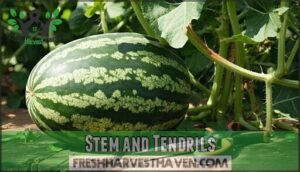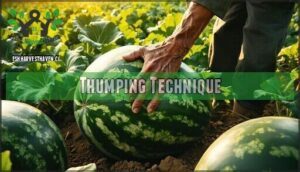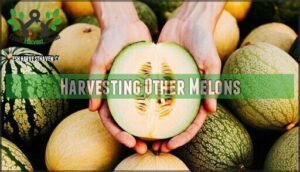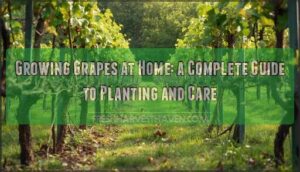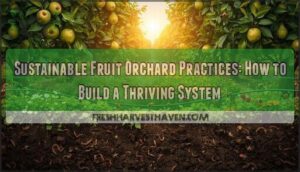This site is supported by our readers. We may earn a commission, at no cost to you, if you purchase through links.
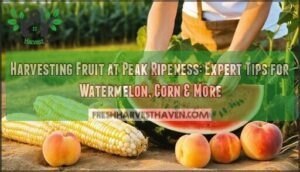 In the case of harvesting fruit at peak ripeness, you’ll want to trust your senses—look, touch, and even listen.
In the case of harvesting fruit at peak ripeness, you’ll want to trust your senses—look, touch, and even listen.
For most fruits, a gentle squeeze tells you plenty; ripe peaches and plums should feel soft near the stem but not mushy, while avocados yield just a bit.
Watermelons are trickier—check for a creamy yellow spot underneath and a dry, curling tendril near the stem.
Give it a thump; a deep, hollow sound means it’s ready.
Corn is best when the silks turn brown and the kernels squirt juice.
There’s an art to picking at just the right moment—stick around for secrets on getting it perfect every time, and learn to trust your senses.
Table Of Contents
- Key Takeaways
- Watermelon Harvesting Basics
- Identifying Ripe Watermelon
- Harvesting Other Melons
- Picking Corn at Peak Ripeness
- Tomato Harvesting Strategies
- Frequently Asked Questions (FAQs)
- Which of the following fruits should be picked only at the peak of ripeness?
- Is frozen fruit picked at peak ripeness?
- What fruit takes the longest time to ripen?
- What is the right time to harvest fruits?
- Can you pick fruit before its ripe?
- What is the best time to harvest fruit?
- What is the best stage of harvesting fruit?
- What does the Bible say about harvesting fruit?
- What fruit takes the longest to ripen?
- What is the best stage of harvesting fruits?
- Conclusion
Key Takeaways
- Trust your senses—look, touch, and even listen—to spot peak ripeness in each fruit.
- Pick watermelons and cantaloupes only when fully ripe, since they won’t sweeten after harvest.
- Use clear signs like color, aroma, and gentle pressure to know when fruit is ready to pick.
- Harvest at the right time for the best flavor, juiciness, and nutrition—don’t rush the process.
Watermelon Harvesting Basics
When you’re harvesting watermelon, timing makes all the difference because the fruit won’t ripen any further once picked.
You’ll need to watch for a few key signs on the vine to guarantee your watermelon reaches its peak flavor and texture.
Timing The Harvest
Even if you’re keen to slice into a fresh watermelon, patience pays off at harvest timing.
Keep an eye on Ripening Factors, like the days since planting and recent weather, since these impact your Harvest Windows and Storage Impact.
Daily checks for Ideal Indicators—such as color and firmness—help you catch peak ripeness.
Harvesting at the right moment boosts flavor, guarantees juiciness, and brings Economic Gains.
- *A well-timed harvest means you’ll enjoy the sweetest, most memorable fruit of the season.
Knowing When to Pick
Once you’ve got the timing down, shift your focus to ripeness indicators.
For watermelons, check for a creamy yellow ground spot and a brown, shriveled tendril near the stem.
Thump it—listen for that deep, hollow sound, the classic sign of ripe fruit.
Soil temperature matters because warmer soil encourages faster sugar development.
Weather effects and variety differences can change harvest readiness, so taste sampling helps confirm peak ripeness.
Regular checks guarantee you don’t miss perfect timing.
Identifying Ripe Watermelon
Determining a watermelon’s ripeness takes practice, but you’ll master the technique with these reliable visual and auditory cues.
Look for the telltale ground spot, check the stem condition, and listen for that perfect hollow thump that signals peak sweetness.
Color Indicators
Once you’ve mastered the basics, let color development guide your next move.
Watermelon ripeness is all about visual assessment. Watch for these color indicators:
- A creamy yellow ground spot—no green tinge—shows peak ripeness.
- Uniform coloring and bold hue variations between stripes signal a ripe fruit.
- The ripeness spectrum shifts as the rind deepens from pale to vibrant.
Trust these fruit color cues for perfect fruit harvesting every time.
Stem and Tendrils
When you’re sizing up a watermelon for harvest, pay close attention to the tendrils near the stem. A brown, withered tendril signals ripe fruit, while a green one means you should wait.
This Tendril Color Change is a classic ripeness indicator. As the stem dries, Stem Ripening Signals and Stem Sugar Content peak.
Use sharp shears for Stem Detachment Ease, supporting the fruit to preserve flavor and prevent bruising during harvesting. Proper harvesting may require specialized fruit tools.
Thumping Technique
A reliable way to check if your watermelon is at peak ripeness is the thumping technique. Give the melon a solid tap and listen closely—the sound factor is key. A deep, hollow thump signals ripe fruit, while a dull thud means it’s not ready.
A specialized tool can assist with consistent watermelon checks.
Here’s how to boost your thump accuracy:
- Hold the melon steady for consistent sound interpretation.
- Thump the center, not the edges, for accurate melon density.
- Practice for experienced thumping, considering rind thickness.
Harvesting Other Melons
Melon season is a sweet reward, but each Melon Variety—cantaloupe, honeydew, or Galia—asks for attention to detail.
Spotting ripe melons isn’t guesswork if you know these three Ripeness Indicators:
- Color Shift: Honeydews turn creamy yellow, Galia melons show golden netting, and cantaloupe skin shifts from green to tan.
- Touch Test: Ripe melons feel heavy for their size and yield slightly at the blossom end.
- Aroma: A sweet, fragrant scent near the stem signals readiness.
Use gentle Harvesting Techniques, like cutting stems with sanitized tools, to avoid bruising.
For Post-Harvest Handling, cool melons quickly and store between 45-55°F—these Storage Methods keep your harvest fresh and flavorful.
Consider tools for cantaloupe harvesting to streamline the process.
Picking Corn at Peak Ripeness
A ripe ear of corn is a treasure—timing is everything if you want peak flavor.
Watch for the Corn Milk Stage: silks turn brown and dry, and kernels look creamy and plump. Gently peel back the husk, check for milky juice, and use your thumb to test firmness.
Snap the ear upward for a clean harvest. Cool your corn right away to lock in sweetness.
Here’s a quick reference:
| Indicator | What to Look For |
|---|---|
| Silk Color Matters | Brown, dry silks |
| Kernel Appearance | Plump, milky, opaque |
Tomato Harvesting Strategies
Unlike corn’s fleeting sweetness, tomatoes offer more flexibility in determining ripeness. You can harvest them at different stages and still achieve peak flavor through proper handling techniques.
Master these harvesting strategies:
- Color Maturity Assessment: Watch for glossy skin with vibrant, even coloration throughout the fruit.
- Firmness Testing: Gently squeeze to check texture—ripe tomatoes yield slightly but remain firm to prevent blossom-end rot.
- Variety Differences Recognition: Different cultivars show unique ripening patterns, so learn your specific tomato’s characteristics.
- Cracking Prevention Timing: Pick slightly underripe tomatoes during wet weather to avoid splits while picking tomatoes.
Harvesting fully ready tomatoes guarantees maximal flavor, though tomatoes continue ripening indoors at room temperature. To encourage further production, consider harvesting ripe tomatoes.
Frequently Asked Questions (FAQs)
Which of the following fruits should be picked only at the peak of ripeness?
Watermelons and cantaloupes should be picked only at their peak, because they won’t sweeten or develop more flavor after harvest.
If you wait for that perfect moment, you’ll enjoy fruit that’s juicy, sweet, and full of character.
Is frozen fruit picked at peak ripeness?
Think of frozen fruit like a snapshot in time—picked right when it’s bursting with flavor and nutrients.
You get the best taste and nutrition because growers freeze fruit soon after harvesting, locking in peak ripeness.
What fruit takes the longest time to ripen?
If you’re curious about slowpokes, avocados often take the longest to ripen after picking, sometimes stretching over a week.
Their rock-hard texture softens gradually, so patience is key if you want that creamy, buttery goodness.
What is the right time to harvest fruits?
If you harvest too early, it’s like biting into a promise that never delivers.
Wait until fruits show rich color, soften just enough, give off a sweet aroma, and detach easily—nature’s way of saying, “Now’s the time!”
Can you pick fruit before its ripe?
You can pick fruit before it’s ripe, but most won’t sweeten or develop their best flavor off the plant.
Some, like bananas, finish ripening after picking, but others, like melons, need time on the vine.
What is the best time to harvest fruit?
You’ll want to grab fruit when it’s fully colored, slightly soft, and fragrant, slipping easily from the branch.
A quick taste test never hurts—sweetness and aroma signal it’s showtime.
Daily checks help you catch that perfect window.
What is the best stage of harvesting fruit?
You’re aiming for that sweet spot when fruit shows full color, gives slightly to pressure, and smells inviting.
If it slips off the stem with a gentle twist, you know you’ve hit the jackpot for taste and nutrition.
What does the Bible say about harvesting fruit?
Scripture sprinkles stories about sowing and reaping, reminding you to gather what you’ve grown in due season.
The Bible often uses fruit harvests as metaphors for patience, diligence, and enjoying blessings after honest, steady work.
What fruit takes the longest to ripen?
If you’re watching the calendar, you’ll notice some fruits test your patience—persimmons and certain apple varieties can take months on the tree to fully ripen.
Their slow journey means more time for sugars and flavors to develop.
What is the best stage of harvesting fruits?
The best stage for harvesting fruits is when they’re fully colored, slightly soft to the touch, and release a sweet aroma.
If a gentle twist lets them go, you’ve hit the sweet spot—literally and figuratively.
Conclusion
Much like a skilled musician tuning their instrument, harvesting fruit at peak ripeness requires attention and practice.
Trust your senses—sight, touch, and even sound—to guide you. Whether you’re thumping watermelons or checking corn silk, these small steps make a big difference in flavor and texture.
Don’t rush; let each fruit tell you when it’s ready. With these tips, you’ll pick produce at its best, enjoying the rewards of your careful timing and observation.
- https://freshharvesthaven.com/harvesting-ripe-fruit/
- https://naturehills.com/blogs/garden-blog/when-will-my-fruit-be-ready-to-harvest
- https://extension.psu.edu/harvesting-fruit-in-the-home-fruit-planting
- https://hiddenorchard.org/is-it-ripe/
- https://www.fast-growing-trees.com/blogs/plant-care-guides/fruit-trees-101-harvesting


